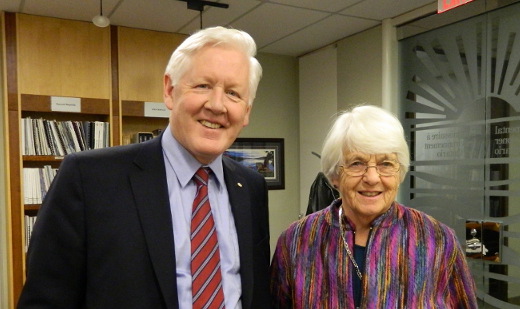
In the 1990 provincial election, Bob Rae led the New Democratic Party of Ontario to a surprising majority government. He had an aggressive environmental agenda. Here's the story.
In the 1990 provincial election, Bob Rae led the New Democratic Party of Ontario to an unexpected majority government. He succeeded David Peterson as Premier of Ontario and became the 21st Premier and the first New Democrat to hold this office. In choosing his Cabinet, he appointed many previously-elected Members of Provincial Parliament (MPPs) who as opposition critics had developed expertise in their portfolios. Ruth Grier, Rae’s trusted environment critic since her election in Etobicoke-Lakeshore in 1985, became the NDP’s first Minister of the Environment.
Rae’s interest in environmental issues began in the late 1960s when, as a student at the University of Toronto, he attended the early meetings that led to the creation of Pollution Probe. After graduation, he became a lawyer for the United Steelworkers of America. Working with union activists, he saw the links between health and safety concerns for workers and environmental issues for the public. When he was elected leader of the Ontario New Democratic Party in 1982, he gave environmental issues a high profile through his questions in the Legislature, by touring affected areas like the polluted Niagara River, and by supporting the task forces and reports of NDP MPPs on topics like energy, forestry and health and safety. In the 1985 election after the Tories were returned with a slim minority, he entered into an agreement – called the Accord – with David Peterson, the leader of the opposition Liberals. In return for implementing the Accord that would last two years, Rae would support the Liberals in forming a government. The Accord required the Liberals to implement a spills bill, which had been the law for many years but never proclaimed (i.e. implemented). The Spills Bill made those who created spills responsible for the cleanup. The Accord also included a commitment to form a Standing Committee on Energy to oversee Ontario Hydro, to pass freedom of information legislation, and to introduce toxic substances regulations under Ontario’s Occupational Health and Safety Act. At the end of two years, the Liberals called an election and won a solid majority, governing for 3 years until 1990. During this time, as leader of the opposition Rae continued to press the government on environmental issues. In 1989, e made headlines when he was arrested in the Temagami area of northeastern Ontario after joining protesters trying to save the old growth forests.
In 1990, when Rae became Premier, public opinion polls showed that environmental issues were still very important even though the province had started to slide into recession. Despite the fiscal challenges, the government remained committed to an environmental agenda that saw sustainability not just as the sole responsibility of the Minister of the Environment but as a philosophy that needed to underpin all Ministries and their programs. In the 1990 election, Rae had campaigned on an “Agenda for the People”, which included a number of environmental promises – the right to a clean environment and clean air, to reducing garbage through recycling, to the preservation of agricultural lands, to the improvement of public transit and to responding to needs of native people. One of the first actions of the NDP government was to commit to introducing an Environmental Bill of Rights, which became a significant piece of environmental legislation for the Rae government when it became law in 1993. As well, Environment Minister Grier banned the incineration of waste and introduced “3Rs” regulations that required municipalities to recycle specific materials. She attempted to find a solution to Toronto’s growing garbage problems but ran into opposition from municipalities and citizens around the Greater Toronto Area (GTA) who fiercely contested the proposed landfill sites. In addition, an NDP private member’s bill that would prohibit new waste disposal sites in the Niagara Escarpment Plan Area passed into law. Under the Municipal-Industrial Strategy for Abatement, introduced by Grier’s predecessor, Liberal Environment Minister, Jim Bradley, monitoring had been required of major industrial water polluters. Grier followed up with stringent regulations focussed on pollution prevention, the first of which compelled the pulp and paper industry to eliminate dioxins and furans from its effluent. Like Bradley, Grier’s advisers were also committed and experienced environmentalists -- Joyce McLean from Greenpeace, and Linda Pim and Anne Wordsworth, both of whom had first worked at Pollution Probe and then in the NDP research office at the Ontario Legislature.
In opposition, Rae had tried but failed to persuade the Liberals to cancel the expansion of the Darlington nuclear power plant during the Accord period. Because so much money had been invested in Darlington by the time the NDP came to power, the government had no choice but to finish it. However, the NDP put in place a moratorium on further nuclear development and shifted the emphasis to energy efficiency and conservation. Conservation programs were introduced by Brian Charlton at the Ministry of Energy and by Maurice Strong as the Chair of Ontario Hydro. Other Ministries were also engaged in putting into place sustainable policies, which Rae actively encouraged and supported. Bud Wildman, as Minister of Natural Resources, developed the Crown Forest Sustainability Act to protect the long-term viability of Ontario’s forests. Howard Hampton, who succeeded Wildman at Natural Resources, began the consultations on provincial parks that would eventually expand Ontario’s parks system. Elmer Buchanan as Minister of Agriculture and Food introduced protections on the Niagara fruit lands, and Minister of Transportation Gilles Pouliot oversaw an ambitious transportation plan for the Greater Toronto Area, and construction on one of three new subway lines was begun. Rae’s vision for his time in government was both sustainable and collaborative. He championed “a new way of doing things” that brought together many disparate interests, including environmentalists, workers, First Nations and industry to collaborate with government, and he incorporated environmental concerns into the NDP government’s day-to day-decision-making.
